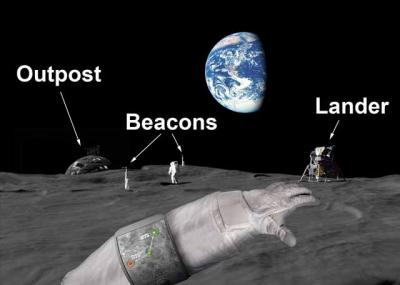
The Crazy Lune

 |
The Crazy Lune |
 |
|---|
      |
|
Astronaut-Lander link
|
|
Design trade-offs:
The optimization procedure described elsewhere is performed across a range of RF bandwidths and link distances in order to explore the design limits and tradeoffs.
A fundamental tradeoff exists between the bitrate and minimum transmit power. Increasing the signal bandwidth will allow a higher bitrate, but will also increase the received noise power. In order to have a sufficiently low bit error rate (BER), the carrier-to-noise ratio (CNR) must remain above a certain threshold. Thus, for all other conditions fixed, increasing the bandwidth will increase the noise power and require a corresponding increase in transmit power in order to maintain the necessary CNR, as illustrated by the link calculations given in Figure 3.
Similarly, a tradeoff exists between link distance and transmit power. With greater distance comes greater link loss, requiring an increase in transmit power, as shown in Figure 1. Consequently, both bitrate and distance can be improved by increasing the transmit power, but the transmit power is highly limited since the astronaut must carry all his power in the form of batteries. As such, when the transmit power is increased, the potential performance gains must be divided between the bitrate and maximum distance. In this way, there is a third tradeoff between the bitrate and maximum distance, since each of these directly affect the noise power. This tradeoff is clearly shown in Figure 2, in which there is no way to simultaneously achieve a large distance and bitrate.
Link operation protocol: For the optimal use of resources, we have designed an intelligent protocol for the astronaut-lander link operation that avoids excessive use of power or bitrate.
Our iLink protocol builds upon the following capabilities:
The astronaut-lander link is designed to be able to step between a set of discrete bitrates. At lower bitrates, the link is able to be maintained at significantly lower power levels, since less noise is introduced into the link and hence can tolerate a lower received signal power. This tradeoff is illustrated in Figure 3. Since the astronaut does not always need extremely high bitrates, the bitrate can be intelligently adjusted according to the needs of each moment.
Throughout a moonwalk the received signal power from the astronaut will be highly variable due to constant changes in link distance and variation in propagation losses. We leverage the fact that for much of the moonwalk the astronaut will likely not be near the edge of coverage. Because of this, much of the time the astronaut needs to transmit at only a fraction of what is required at the edge of coverage. We have built in to the transmission protocol the ability for the astronaut transmit power to dynamically adjust according to the CNR received at the lander. The lander will continuously report its CNR to the astronaut's onboard computer, which will adjust the transmit power so that the CNR remains only slightly above the minimum required for near errorless transmission. This will drastically reduce the power consumption of this link, reducing the required battery capacity. Performance benchmarks:
The raw link performance is most clearly shown in Figure 1 below, demonstrating the maximum sustainable distance for the different bitrate levels as the transmit power is ramped up. With a peak transmit power of 5W, our iLink is capable of sustaining 10 Mbps real data rate up to a distance of 6 km, or a 50 Mbps real data rate up to a distance of 4 km.
Figure 1. Maximum distance allowed in astronaut-lander link vs. transmit power for various levels of link bitrate.
Figure 2. Maximum sustainable bitrate vs. distance from lander for various transmit power levels.
|
Home | Project | Communication | Location | Power | Budget & Timeline Tuesday, December 8, 2009 © 2009 The Crazy Lune. All rights reserved. |